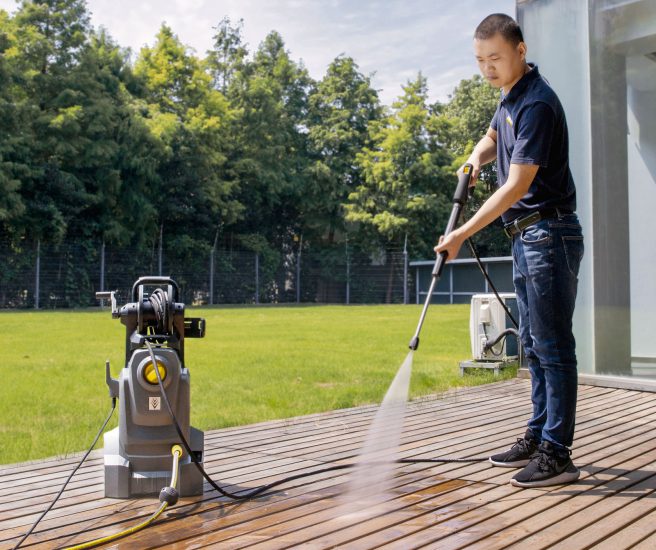High-pressure cleaning, also known as pressure washing, has become a staple in the realm of surface cleaning, revolutionizing how we tackle dirt, grime, and stains on various surfaces. From residential driveways to industrial machinery, the power of high-pressure cleaning is undeniable. In this comprehensive guide, we will delve into the basics of high-pressure cleaning, exploring its benefits, applications, equipment, safety measures, and more. If you’re seeking professional pressure cleaners in Gold Coast to enhance the cleanliness and appearance of your surfaces, we’ll also provide insights and considerations to help you make informed choices for your specific needs. Whether it’s for residential or commercial purposes, finding the right pressure cleaning services in Gold Coast can make a significant difference in achieving optimal results.
Introduction to High Pressure Cleaning
High-pressure cleaning involves the use of a specialized washer that propels water at high speeds, effectively cleaning surfaces with stubborn stains and accumulated dirt. This method has gained immense popularity due to its efficiency and versatility in various settings.
Benefits of High Pressure Cleaning
Removes Stubborn Stains and Dirt
One of the primary advantages of high-pressure cleaning is its ability to eliminate even the toughest stains and dirt. Whether it’s oil stains on the driveway or graffiti on a wall, the powerful stream of water can restore surfaces to their original state.
Enhances the Aesthetic Appeal of Surfaces
The transformative effect of high-pressure cleaning on surfaces is truly remarkable. Driveways regain their pristine appearance, and outdoor furniture can look brand new with a thorough cleaning session.
Environmental Advantages
Contrary to common misconceptions, high-pressure cleaning can be environmentally friendly. It reduces the need for harsh chemical cleaners, and the efficient use of water minimizes wastage.
Types of Surfaces Suitable for High Pressure Cleaning
High-pressure cleaning is versatile and can be applied to various surfaces. Some of the most common surfaces suitable for this method include:
- Concrete driveways and sidewalks
- Wooden decks and fences
- Exterior walls and siding
Equipment Needed for High Pressure Cleaning
To embark on a high-pressure cleaning venture, it’s essential to have the right equipment. The following items are crucial for a successful cleaning operation:
- High-pressure washer
- Nozzles and attachments for different surfaces
- Safety gear for operators, including goggles and gloves
Safety Precautions and Guidelines
While high-pressure cleaning is highly effective, safety should always be a top priority. Here are some key precautions and guidelines to follow:
- Read the user manual thoroughly before operation
- Wear proper protective gear, including eye protection and gloves
- Follow the manufacturer’s guidelines for safe operation
Step-by-Step Guide for High Pressure Cleaning
Preparing the Surface
Before starting the high-pressure cleaning process, it’s important to prepare the surface. This may involve removing loose debris, sweeping the area, and applying any necessary cleaning agents.
Setting up the Equipment
Proper setup of the high-pressure washer is crucial for optimal performance. Ensure that all connections are secure, and choose the appropriate nozzle for the specific task at hand.
Executing the Cleaning Process
Once everything is in place, begin the cleaning process by holding the nozzle at a consistent distance from the surface. Move in a sweeping motion, overlapping each pass for thorough cleaning.
Common Mistakes to Avoid
Using Excessive Pressure
One common mistake is using excessively high pressure, which can damage sensitive surfaces. Always start with the lowest pressure setting and gradually increase if needed.
Neglecting Safety Measures
Ignoring safety precautions can lead to accidents and injuries. Always wear the recommended safety gear and follow operational guidelines diligently.
Ignoring Surface-Specific Guidelines
Different surfaces may require different approaches. Always consider surface-specific guidelines to avoid damage during the cleaning process.
Applications in Residential Settings
High-pressure cleaning has numerous applications in residential settings, including:
- Cleaning driveways and walkways
- Revitalizing outdoor furniture
- Improving curb appeal
Applications in Commercial and Industrial Settings
Graffiti Removal
High-pressure cleaning is an effective method for graffiti removal, restoring surfaces without causing damage.
Maintenance of Large Surfaces
In commercial and industrial settings, maintaining large surfaces becomes more manageable with the power of high-pressure cleaning.
Cleaning Equipment and Machinery
Industrial machinery and equipment can benefit from regular high-pressure cleaning to ensure optimal performance and longevity.
Environmental Considerations
While high-pressure cleaning is powerful, it’s essential to be mindful of the environment. Consider the following environmental considerations:
- Water conservation practices
- Use of eco-friendly cleaning agents
- Minimizing runoff by directing water responsibly
Cost and Investment in High Pressure Cleaning
Initial Equipment Costs
Investing in high-pressure cleaning equipment can vary in cost. Consider the size of the area you plan to clean and choose equipment that suits your needs.
Long-Term Savings on Maintenance
Regular high-pressure cleaning can contribute to long-term savings by preventing the need for extensive maintenance and repairs.
Hiring Professionals vs. DIY
Deciding between hiring professionals and tackling high-pressure cleaning as a DIY project depends on various factors, including the size of the job and personal expertise.
